Challenges Facing Australia's Multicultural Society
VerifiedAdded on 2020/06/03
|7
|2413
|489
AI Summary
This assignment analyzes the various challenges confronting Australia's multicultural society. It delves into issues such as unemployment, poor health outcomes, poverty, racial discrimination, and the impact of these factors on the mental well-being of individuals within this community. Furthermore, the essay explores gender inequality in Australia and its effects on women. The assignment utilizes sociological perspectives and statistical data to shed light on these complex societal problems.
Contribute Materials
Your contribution can guide someone’s learning journey. Share your
documents today.
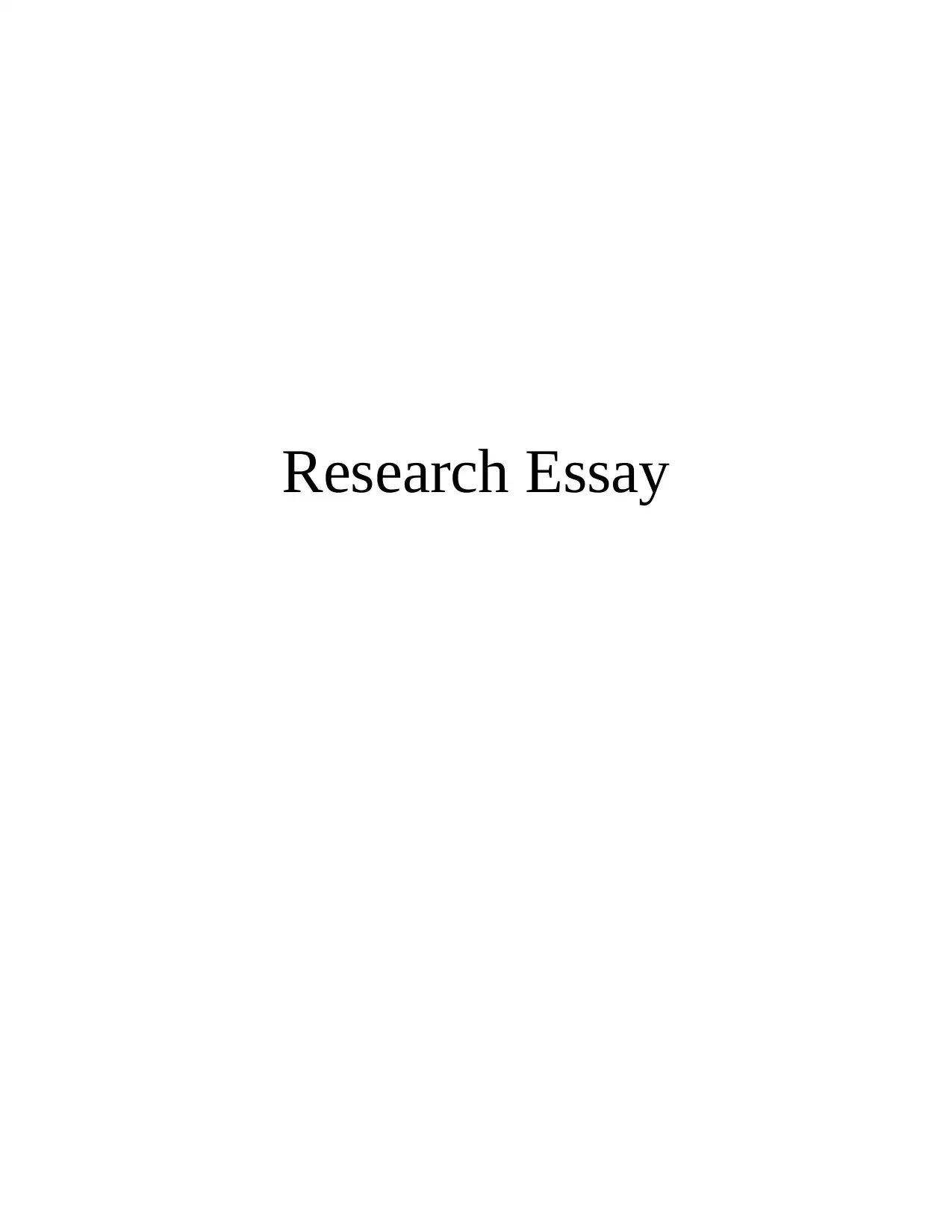
Research Essay
Secure Best Marks with AI Grader
Need help grading? Try our AI Grader for instant feedback on your assignments.
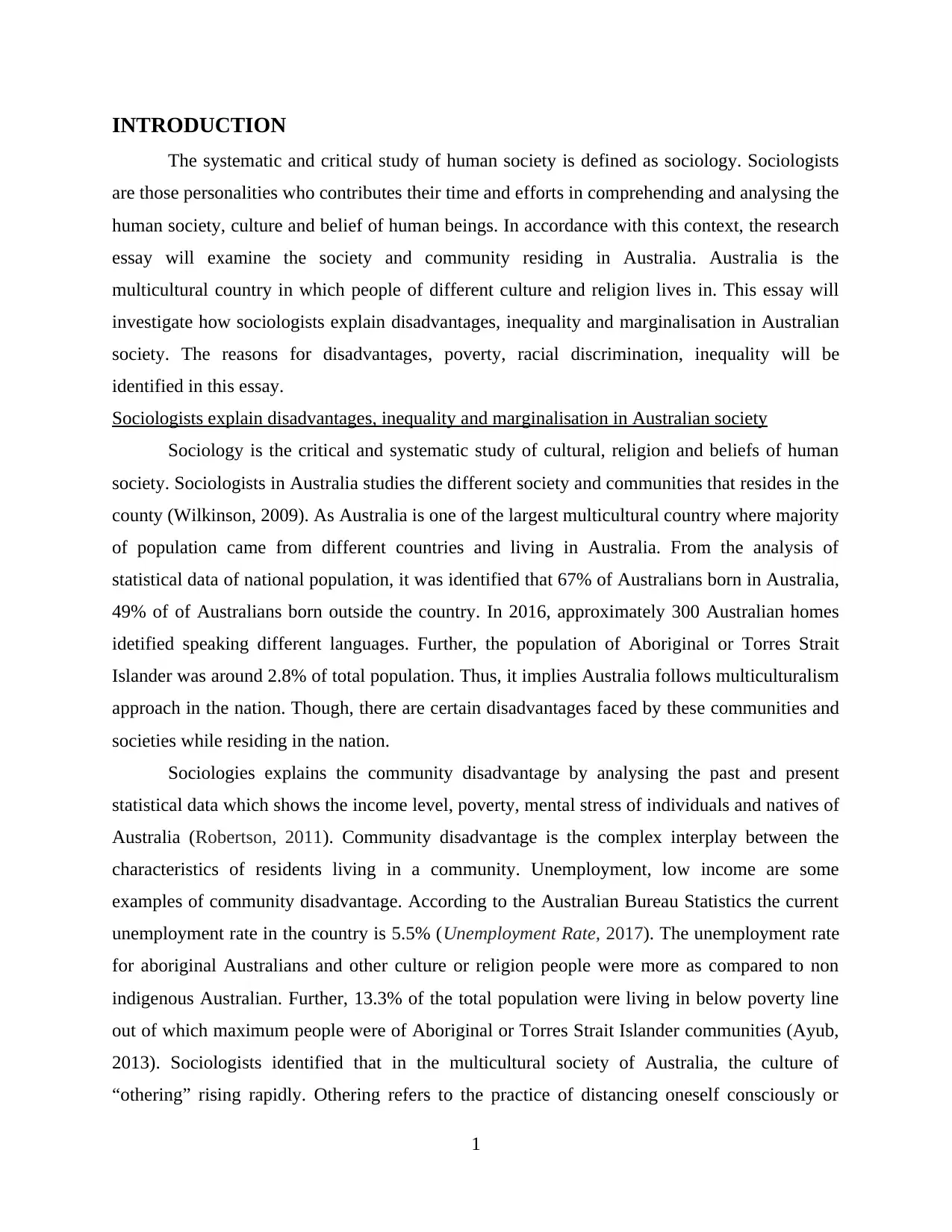
INTRODUCTION
The systematic and critical study of human society is defined as sociology. Sociologists
are those personalities who contributes their time and efforts in comprehending and analysing the
human society, culture and belief of human beings. In accordance with this context, the research
essay will examine the society and community residing in Australia. Australia is the
multicultural country in which people of different culture and religion lives in. This essay will
investigate how sociologists explain disadvantages, inequality and marginalisation in Australian
society. The reasons for disadvantages, poverty, racial discrimination, inequality will be
identified in this essay.
Sociologists explain disadvantages, inequality and marginalisation in Australian society
Sociology is the critical and systematic study of cultural, religion and beliefs of human
society. Sociologists in Australia studies the different society and communities that resides in the
county (Wilkinson, 2009). As Australia is one of the largest multicultural country where majority
of population came from different countries and living in Australia. From the analysis of
statistical data of national population, it was identified that 67% of Australians born in Australia,
49% of of Australians born outside the country. In 2016, approximately 300 Australian homes
idetified speaking different languages. Further, the population of Aboriginal or Torres Strait
Islander was around 2.8% of total population. Thus, it implies Australia follows multiculturalism
approach in the nation. Though, there are certain disadvantages faced by these communities and
societies while residing in the nation.
Sociologies explains the community disadvantage by analysing the past and present
statistical data which shows the income level, poverty, mental stress of individuals and natives of
Australia (Robertson, 2011). Community disadvantage is the complex interplay between the
characteristics of residents living in a community. Unemployment, low income are some
examples of community disadvantage. According to the Australian Bureau Statistics the current
unemployment rate in the country is 5.5% (Unemployment Rate, 2017). The unemployment rate
for aboriginal Australians and other culture or religion people were more as compared to non
indigenous Australian. Further, 13.3% of the total population were living in below poverty line
out of which maximum people were of Aboriginal or Torres Strait Islander communities (Ayub,
2013). Sociologists identified that in the multicultural society of Australia, the culture of
“othering” rising rapidly. Othering refers to the practice of distancing oneself consciously or
1
The systematic and critical study of human society is defined as sociology. Sociologists
are those personalities who contributes their time and efforts in comprehending and analysing the
human society, culture and belief of human beings. In accordance with this context, the research
essay will examine the society and community residing in Australia. Australia is the
multicultural country in which people of different culture and religion lives in. This essay will
investigate how sociologists explain disadvantages, inequality and marginalisation in Australian
society. The reasons for disadvantages, poverty, racial discrimination, inequality will be
identified in this essay.
Sociologists explain disadvantages, inequality and marginalisation in Australian society
Sociology is the critical and systematic study of cultural, religion and beliefs of human
society. Sociologists in Australia studies the different society and communities that resides in the
county (Wilkinson, 2009). As Australia is one of the largest multicultural country where majority
of population came from different countries and living in Australia. From the analysis of
statistical data of national population, it was identified that 67% of Australians born in Australia,
49% of of Australians born outside the country. In 2016, approximately 300 Australian homes
idetified speaking different languages. Further, the population of Aboriginal or Torres Strait
Islander was around 2.8% of total population. Thus, it implies Australia follows multiculturalism
approach in the nation. Though, there are certain disadvantages faced by these communities and
societies while residing in the nation.
Sociologies explains the community disadvantage by analysing the past and present
statistical data which shows the income level, poverty, mental stress of individuals and natives of
Australia (Robertson, 2011). Community disadvantage is the complex interplay between the
characteristics of residents living in a community. Unemployment, low income are some
examples of community disadvantage. According to the Australian Bureau Statistics the current
unemployment rate in the country is 5.5% (Unemployment Rate, 2017). The unemployment rate
for aboriginal Australians and other culture or religion people were more as compared to non
indigenous Australian. Further, 13.3% of the total population were living in below poverty line
out of which maximum people were of Aboriginal or Torres Strait Islander communities (Ayub,
2013). Sociologists identified that in the multicultural society of Australia, the culture of
“othering” rising rapidly. Othering refers to the practice of distancing oneself consciously or
1
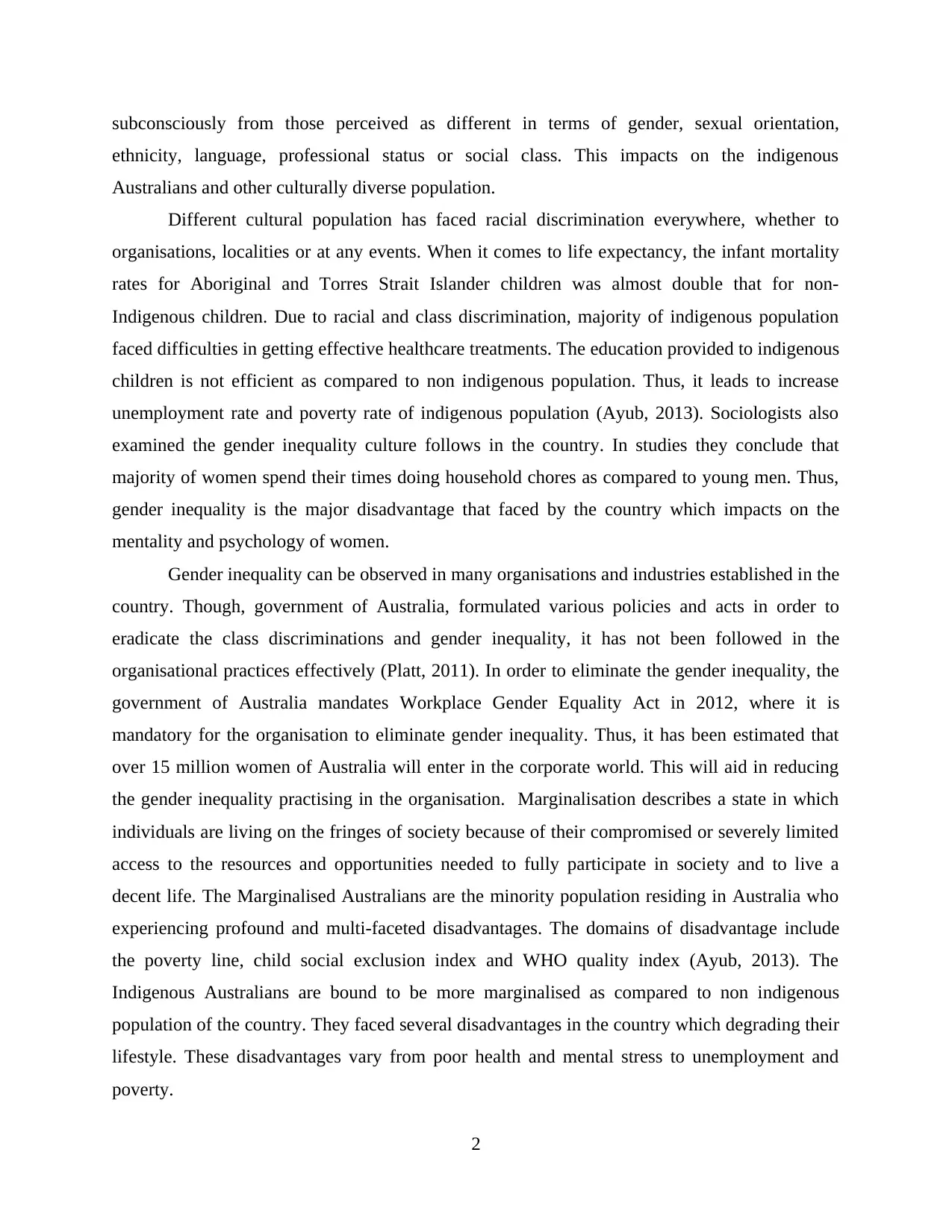
subconsciously from those perceived as different in terms of gender, sexual orientation,
ethnicity, language, professional status or social class. This impacts on the indigenous
Australians and other culturally diverse population.
Different cultural population has faced racial discrimination everywhere, whether to
organisations, localities or at any events. When it comes to life expectancy, the infant mortality
rates for Aboriginal and Torres Strait Islander children was almost double that for non-
Indigenous children. Due to racial and class discrimination, majority of indigenous population
faced difficulties in getting effective healthcare treatments. The education provided to indigenous
children is not efficient as compared to non indigenous population. Thus, it leads to increase
unemployment rate and poverty rate of indigenous population (Ayub, 2013). Sociologists also
examined the gender inequality culture follows in the country. In studies they conclude that
majority of women spend their times doing household chores as compared to young men. Thus,
gender inequality is the major disadvantage that faced by the country which impacts on the
mentality and psychology of women.
Gender inequality can be observed in many organisations and industries established in the
country. Though, government of Australia, formulated various policies and acts in order to
eradicate the class discriminations and gender inequality, it has not been followed in the
organisational practices effectively (Platt, 2011). In order to eliminate the gender inequality, the
government of Australia mandates Workplace Gender Equality Act in 2012, where it is
mandatory for the organisation to eliminate gender inequality. Thus, it has been estimated that
over 15 million women of Australia will enter in the corporate world. This will aid in reducing
the gender inequality practising in the organisation. Marginalisation describes a state in which
individuals are living on the fringes of society because of their compromised or severely limited
access to the resources and opportunities needed to fully participate in society and to live a
decent life. The Marginalised Australians are the minority population residing in Australia who
experiencing profound and multi-faceted disadvantages. The domains of disadvantage include
the poverty line, child social exclusion index and WHO quality index (Ayub, 2013). The
Indigenous Australians are bound to be more marginalised as compared to non indigenous
population of the country. They faced several disadvantages in the country which degrading their
lifestyle. These disadvantages vary from poor health and mental stress to unemployment and
poverty.
2
ethnicity, language, professional status or social class. This impacts on the indigenous
Australians and other culturally diverse population.
Different cultural population has faced racial discrimination everywhere, whether to
organisations, localities or at any events. When it comes to life expectancy, the infant mortality
rates for Aboriginal and Torres Strait Islander children was almost double that for non-
Indigenous children. Due to racial and class discrimination, majority of indigenous population
faced difficulties in getting effective healthcare treatments. The education provided to indigenous
children is not efficient as compared to non indigenous population. Thus, it leads to increase
unemployment rate and poverty rate of indigenous population (Ayub, 2013). Sociologists also
examined the gender inequality culture follows in the country. In studies they conclude that
majority of women spend their times doing household chores as compared to young men. Thus,
gender inequality is the major disadvantage that faced by the country which impacts on the
mentality and psychology of women.
Gender inequality can be observed in many organisations and industries established in the
country. Though, government of Australia, formulated various policies and acts in order to
eradicate the class discriminations and gender inequality, it has not been followed in the
organisational practices effectively (Platt, 2011). In order to eliminate the gender inequality, the
government of Australia mandates Workplace Gender Equality Act in 2012, where it is
mandatory for the organisation to eliminate gender inequality. Thus, it has been estimated that
over 15 million women of Australia will enter in the corporate world. This will aid in reducing
the gender inequality practising in the organisation. Marginalisation describes a state in which
individuals are living on the fringes of society because of their compromised or severely limited
access to the resources and opportunities needed to fully participate in society and to live a
decent life. The Marginalised Australians are the minority population residing in Australia who
experiencing profound and multi-faceted disadvantages. The domains of disadvantage include
the poverty line, child social exclusion index and WHO quality index (Ayub, 2013). The
Indigenous Australians are bound to be more marginalised as compared to non indigenous
population of the country. They faced several disadvantages in the country which degrading their
lifestyle. These disadvantages vary from poor health and mental stress to unemployment and
poverty.
2
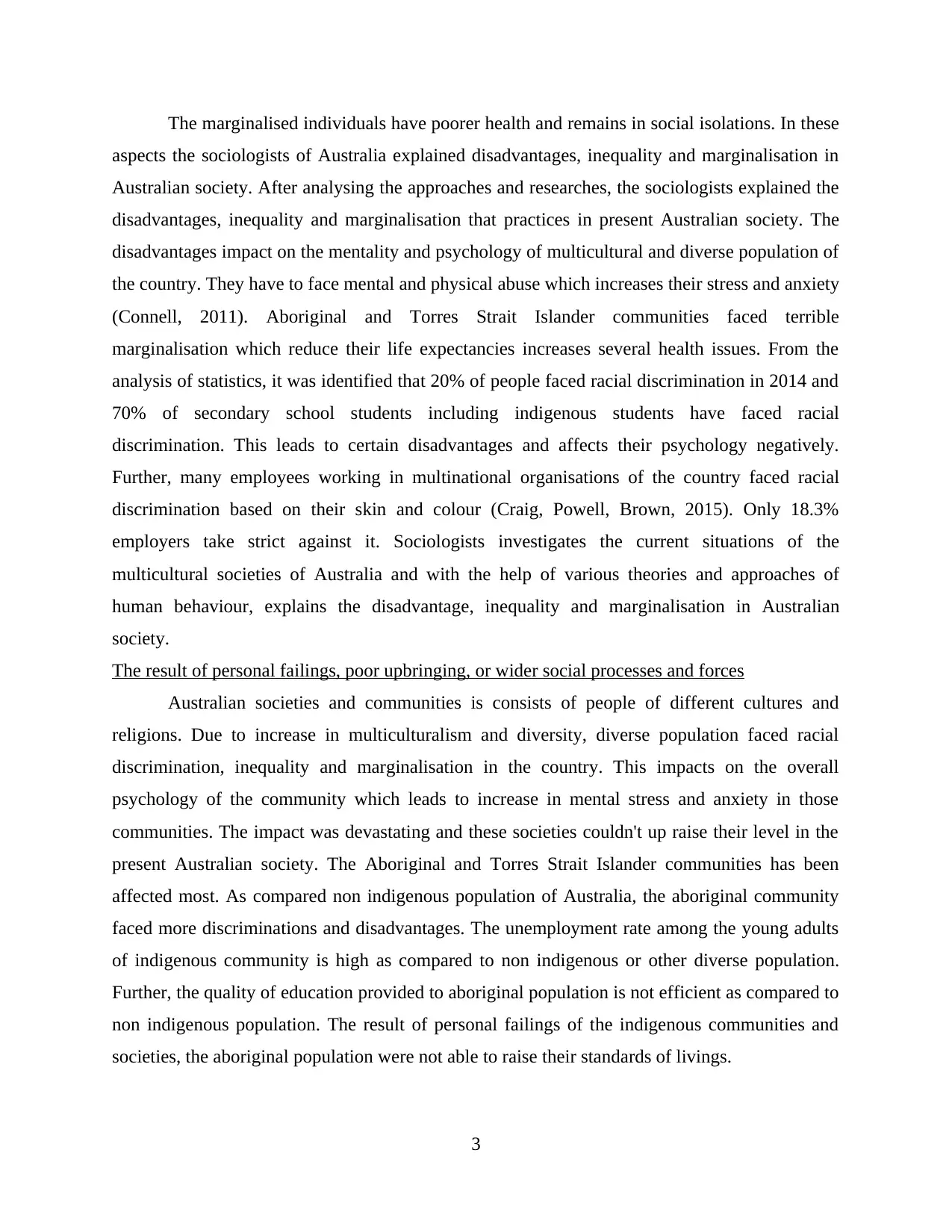
The marginalised individuals have poorer health and remains in social isolations. In these
aspects the sociologists of Australia explained disadvantages, inequality and marginalisation in
Australian society. After analysing the approaches and researches, the sociologists explained the
disadvantages, inequality and marginalisation that practices in present Australian society. The
disadvantages impact on the mentality and psychology of multicultural and diverse population of
the country. They have to face mental and physical abuse which increases their stress and anxiety
(Connell, 2011). Aboriginal and Torres Strait Islander communities faced terrible
marginalisation which reduce their life expectancies increases several health issues. From the
analysis of statistics, it was identified that 20% of people faced racial discrimination in 2014 and
70% of secondary school students including indigenous students have faced racial
discrimination. This leads to certain disadvantages and affects their psychology negatively.
Further, many employees working in multinational organisations of the country faced racial
discrimination based on their skin and colour (Craig, Powell, Brown, 2015). Only 18.3%
employers take strict against it. Sociologists investigates the current situations of the
multicultural societies of Australia and with the help of various theories and approaches of
human behaviour, explains the disadvantage, inequality and marginalisation in Australian
society.
The result of personal failings, poor upbringing, or wider social processes and forces
Australian societies and communities is consists of people of different cultures and
religions. Due to increase in multiculturalism and diversity, diverse population faced racial
discrimination, inequality and marginalisation in the country. This impacts on the overall
psychology of the community which leads to increase in mental stress and anxiety in those
communities. The impact was devastating and these societies couldn't up raise their level in the
present Australian society. The Aboriginal and Torres Strait Islander communities has been
affected most. As compared non indigenous population of Australia, the aboriginal community
faced more discriminations and disadvantages. The unemployment rate among the young adults
of indigenous community is high as compared to non indigenous or other diverse population.
Further, the quality of education provided to aboriginal population is not efficient as compared to
non indigenous population. The result of personal failings of the indigenous communities and
societies, the aboriginal population were not able to raise their standards of livings.
3
aspects the sociologists of Australia explained disadvantages, inequality and marginalisation in
Australian society. After analysing the approaches and researches, the sociologists explained the
disadvantages, inequality and marginalisation that practices in present Australian society. The
disadvantages impact on the mentality and psychology of multicultural and diverse population of
the country. They have to face mental and physical abuse which increases their stress and anxiety
(Connell, 2011). Aboriginal and Torres Strait Islander communities faced terrible
marginalisation which reduce their life expectancies increases several health issues. From the
analysis of statistics, it was identified that 20% of people faced racial discrimination in 2014 and
70% of secondary school students including indigenous students have faced racial
discrimination. This leads to certain disadvantages and affects their psychology negatively.
Further, many employees working in multinational organisations of the country faced racial
discrimination based on their skin and colour (Craig, Powell, Brown, 2015). Only 18.3%
employers take strict against it. Sociologists investigates the current situations of the
multicultural societies of Australia and with the help of various theories and approaches of
human behaviour, explains the disadvantage, inequality and marginalisation in Australian
society.
The result of personal failings, poor upbringing, or wider social processes and forces
Australian societies and communities is consists of people of different cultures and
religions. Due to increase in multiculturalism and diversity, diverse population faced racial
discrimination, inequality and marginalisation in the country. This impacts on the overall
psychology of the community which leads to increase in mental stress and anxiety in those
communities. The impact was devastating and these societies couldn't up raise their level in the
present Australian society. The Aboriginal and Torres Strait Islander communities has been
affected most. As compared non indigenous population of Australia, the aboriginal community
faced more discriminations and disadvantages. The unemployment rate among the young adults
of indigenous community is high as compared to non indigenous or other diverse population.
Further, the quality of education provided to aboriginal population is not efficient as compared to
non indigenous population. The result of personal failings of the indigenous communities and
societies, the aboriginal population were not able to raise their standards of livings.
3
Secure Best Marks with AI Grader
Need help grading? Try our AI Grader for instant feedback on your assignments.
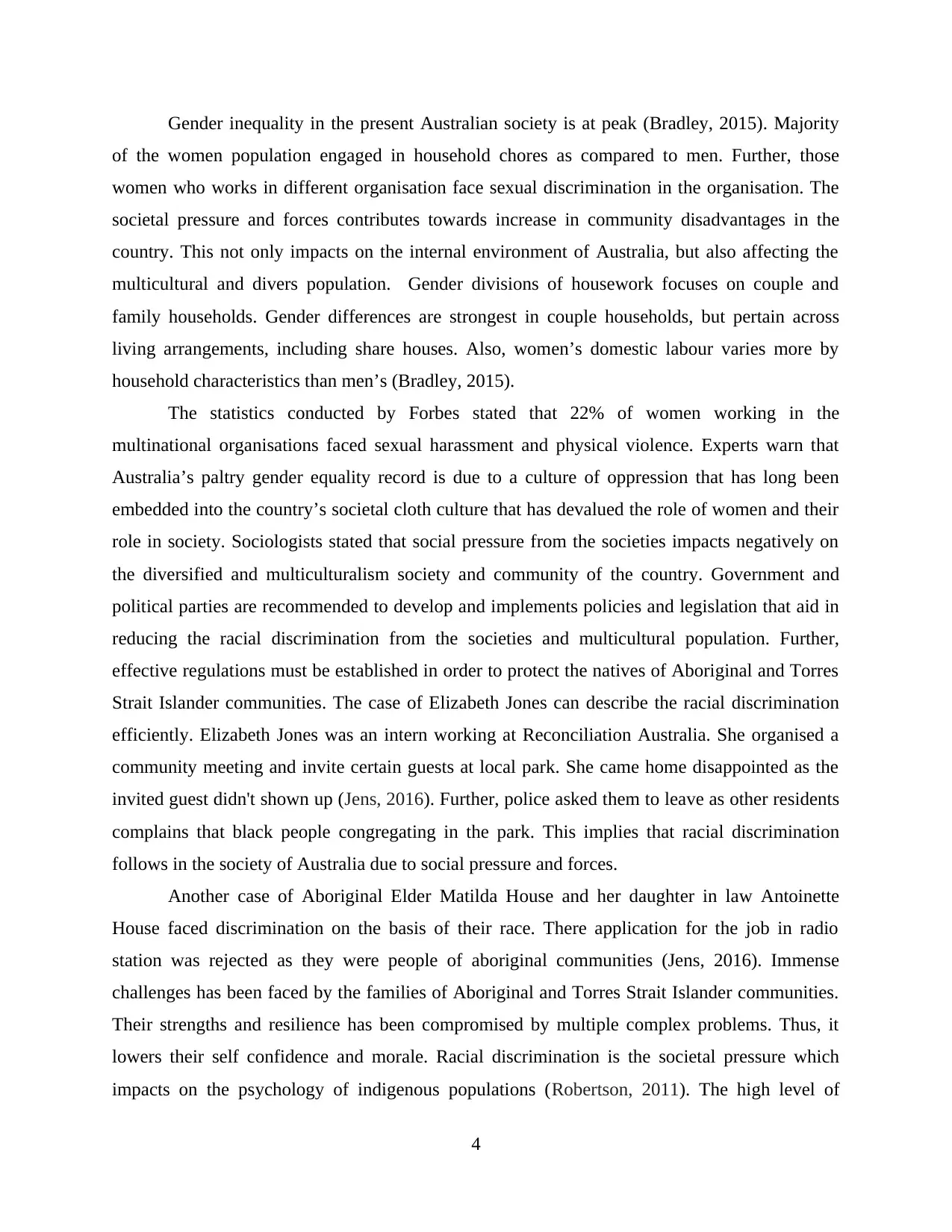
Gender inequality in the present Australian society is at peak (Bradley, 2015). Majority
of the women population engaged in household chores as compared to men. Further, those
women who works in different organisation face sexual discrimination in the organisation. The
societal pressure and forces contributes towards increase in community disadvantages in the
country. This not only impacts on the internal environment of Australia, but also affecting the
multicultural and divers population. Gender divisions of housework focuses on couple and
family households. Gender differences are strongest in couple households, but pertain across
living arrangements, including share houses. Also, women’s domestic labour varies more by
household characteristics than men’s (Bradley, 2015).
The statistics conducted by Forbes stated that 22% of women working in the
multinational organisations faced sexual harassment and physical violence. Experts warn that
Australia’s paltry gender equality record is due to a culture of oppression that has long been
embedded into the country’s societal cloth culture that has devalued the role of women and their
role in society. Sociologists stated that social pressure from the societies impacts negatively on
the diversified and multiculturalism society and community of the country. Government and
political parties are recommended to develop and implements policies and legislation that aid in
reducing the racial discrimination from the societies and multicultural population. Further,
effective regulations must be established in order to protect the natives of Aboriginal and Torres
Strait Islander communities. The case of Elizabeth Jones can describe the racial discrimination
efficiently. Elizabeth Jones was an intern working at Reconciliation Australia. She organised a
community meeting and invite certain guests at local park. She came home disappointed as the
invited guest didn't shown up (Jens, 2016). Further, police asked them to leave as other residents
complains that black people congregating in the park. This implies that racial discrimination
follows in the society of Australia due to social pressure and forces.
Another case of Aboriginal Elder Matilda House and her daughter in law Antoinette
House faced discrimination on the basis of their race. There application for the job in radio
station was rejected as they were people of aboriginal communities (Jens, 2016). Immense
challenges has been faced by the families of Aboriginal and Torres Strait Islander communities.
Their strengths and resilience has been compromised by multiple complex problems. Thus, it
lowers their self confidence and morale. Racial discrimination is the societal pressure which
impacts on the psychology of indigenous populations (Robertson, 2011). The high level of
4
of the women population engaged in household chores as compared to men. Further, those
women who works in different organisation face sexual discrimination in the organisation. The
societal pressure and forces contributes towards increase in community disadvantages in the
country. This not only impacts on the internal environment of Australia, but also affecting the
multicultural and divers population. Gender divisions of housework focuses on couple and
family households. Gender differences are strongest in couple households, but pertain across
living arrangements, including share houses. Also, women’s domestic labour varies more by
household characteristics than men’s (Bradley, 2015).
The statistics conducted by Forbes stated that 22% of women working in the
multinational organisations faced sexual harassment and physical violence. Experts warn that
Australia’s paltry gender equality record is due to a culture of oppression that has long been
embedded into the country’s societal cloth culture that has devalued the role of women and their
role in society. Sociologists stated that social pressure from the societies impacts negatively on
the diversified and multiculturalism society and community of the country. Government and
political parties are recommended to develop and implements policies and legislation that aid in
reducing the racial discrimination from the societies and multicultural population. Further,
effective regulations must be established in order to protect the natives of Aboriginal and Torres
Strait Islander communities. The case of Elizabeth Jones can describe the racial discrimination
efficiently. Elizabeth Jones was an intern working at Reconciliation Australia. She organised a
community meeting and invite certain guests at local park. She came home disappointed as the
invited guest didn't shown up (Jens, 2016). Further, police asked them to leave as other residents
complains that black people congregating in the park. This implies that racial discrimination
follows in the society of Australia due to social pressure and forces.
Another case of Aboriginal Elder Matilda House and her daughter in law Antoinette
House faced discrimination on the basis of their race. There application for the job in radio
station was rejected as they were people of aboriginal communities (Jens, 2016). Immense
challenges has been faced by the families of Aboriginal and Torres Strait Islander communities.
Their strengths and resilience has been compromised by multiple complex problems. Thus, it
lowers their self confidence and morale. Racial discrimination is the societal pressure which
impacts on the psychology of indigenous populations (Robertson, 2011). The high level of
4
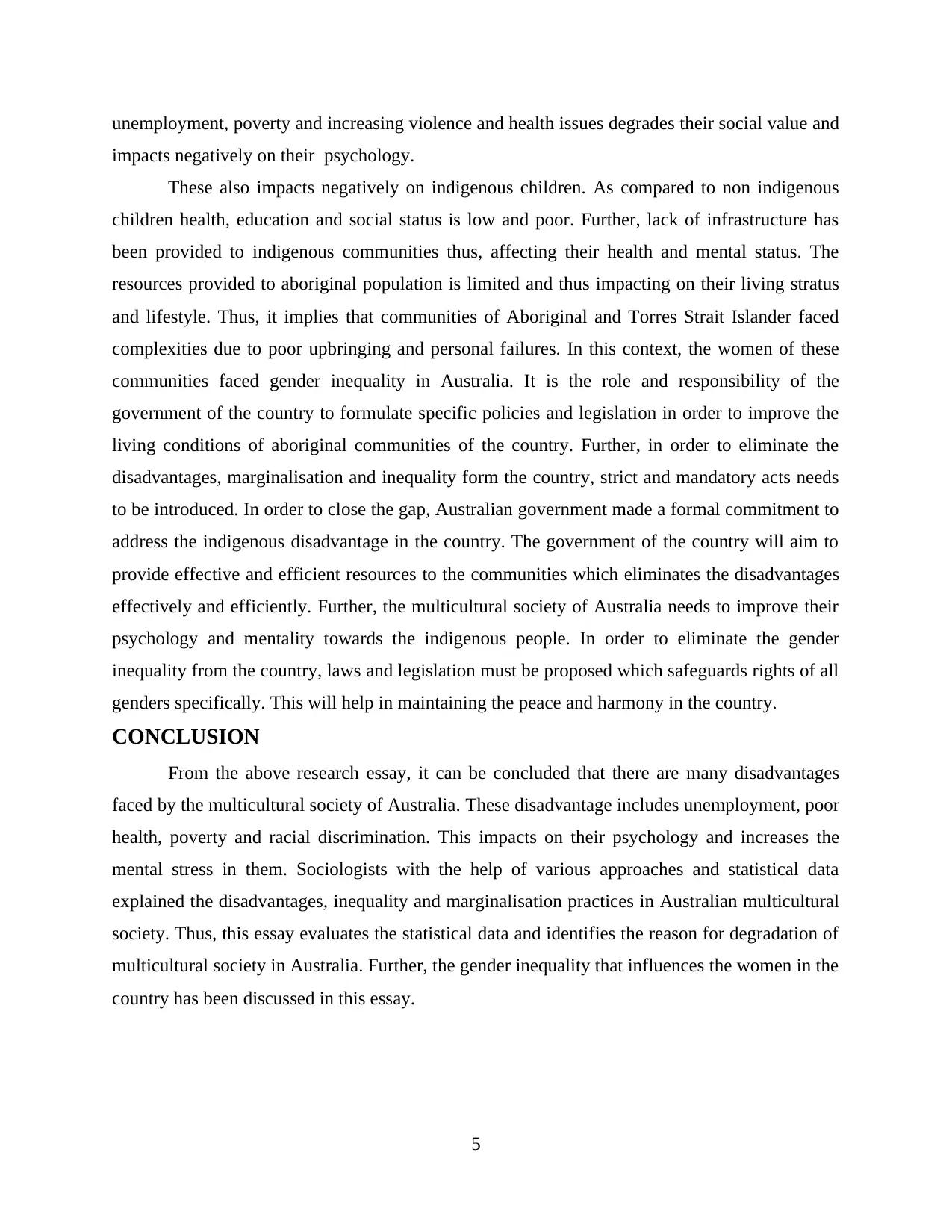
unemployment, poverty and increasing violence and health issues degrades their social value and
impacts negatively on their psychology.
These also impacts negatively on indigenous children. As compared to non indigenous
children health, education and social status is low and poor. Further, lack of infrastructure has
been provided to indigenous communities thus, affecting their health and mental status. The
resources provided to aboriginal population is limited and thus impacting on their living stratus
and lifestyle. Thus, it implies that communities of Aboriginal and Torres Strait Islander faced
complexities due to poor upbringing and personal failures. In this context, the women of these
communities faced gender inequality in Australia. It is the role and responsibility of the
government of the country to formulate specific policies and legislation in order to improve the
living conditions of aboriginal communities of the country. Further, in order to eliminate the
disadvantages, marginalisation and inequality form the country, strict and mandatory acts needs
to be introduced. In order to close the gap, Australian government made a formal commitment to
address the indigenous disadvantage in the country. The government of the country will aim to
provide effective and efficient resources to the communities which eliminates the disadvantages
effectively and efficiently. Further, the multicultural society of Australia needs to improve their
psychology and mentality towards the indigenous people. In order to eliminate the gender
inequality from the country, laws and legislation must be proposed which safeguards rights of all
genders specifically. This will help in maintaining the peace and harmony in the country.
CONCLUSION
From the above research essay, it can be concluded that there are many disadvantages
faced by the multicultural society of Australia. These disadvantage includes unemployment, poor
health, poverty and racial discrimination. This impacts on their psychology and increases the
mental stress in them. Sociologists with the help of various approaches and statistical data
explained the disadvantages, inequality and marginalisation practices in Australian multicultural
society. Thus, this essay evaluates the statistical data and identifies the reason for degradation of
multicultural society in Australia. Further, the gender inequality that influences the women in the
country has been discussed in this essay.
5
impacts negatively on their psychology.
These also impacts negatively on indigenous children. As compared to non indigenous
children health, education and social status is low and poor. Further, lack of infrastructure has
been provided to indigenous communities thus, affecting their health and mental status. The
resources provided to aboriginal population is limited and thus impacting on their living stratus
and lifestyle. Thus, it implies that communities of Aboriginal and Torres Strait Islander faced
complexities due to poor upbringing and personal failures. In this context, the women of these
communities faced gender inequality in Australia. It is the role and responsibility of the
government of the country to formulate specific policies and legislation in order to improve the
living conditions of aboriginal communities of the country. Further, in order to eliminate the
disadvantages, marginalisation and inequality form the country, strict and mandatory acts needs
to be introduced. In order to close the gap, Australian government made a formal commitment to
address the indigenous disadvantage in the country. The government of the country will aim to
provide effective and efficient resources to the communities which eliminates the disadvantages
effectively and efficiently. Further, the multicultural society of Australia needs to improve their
psychology and mentality towards the indigenous people. In order to eliminate the gender
inequality from the country, laws and legislation must be proposed which safeguards rights of all
genders specifically. This will help in maintaining the peace and harmony in the country.
CONCLUSION
From the above research essay, it can be concluded that there are many disadvantages
faced by the multicultural society of Australia. These disadvantage includes unemployment, poor
health, poverty and racial discrimination. This impacts on their psychology and increases the
mental stress in them. Sociologists with the help of various approaches and statistical data
explained the disadvantages, inequality and marginalisation practices in Australian multicultural
society. Thus, this essay evaluates the statistical data and identifies the reason for degradation of
multicultural society in Australia. Further, the gender inequality that influences the women in the
country has been discussed in this essay.
5
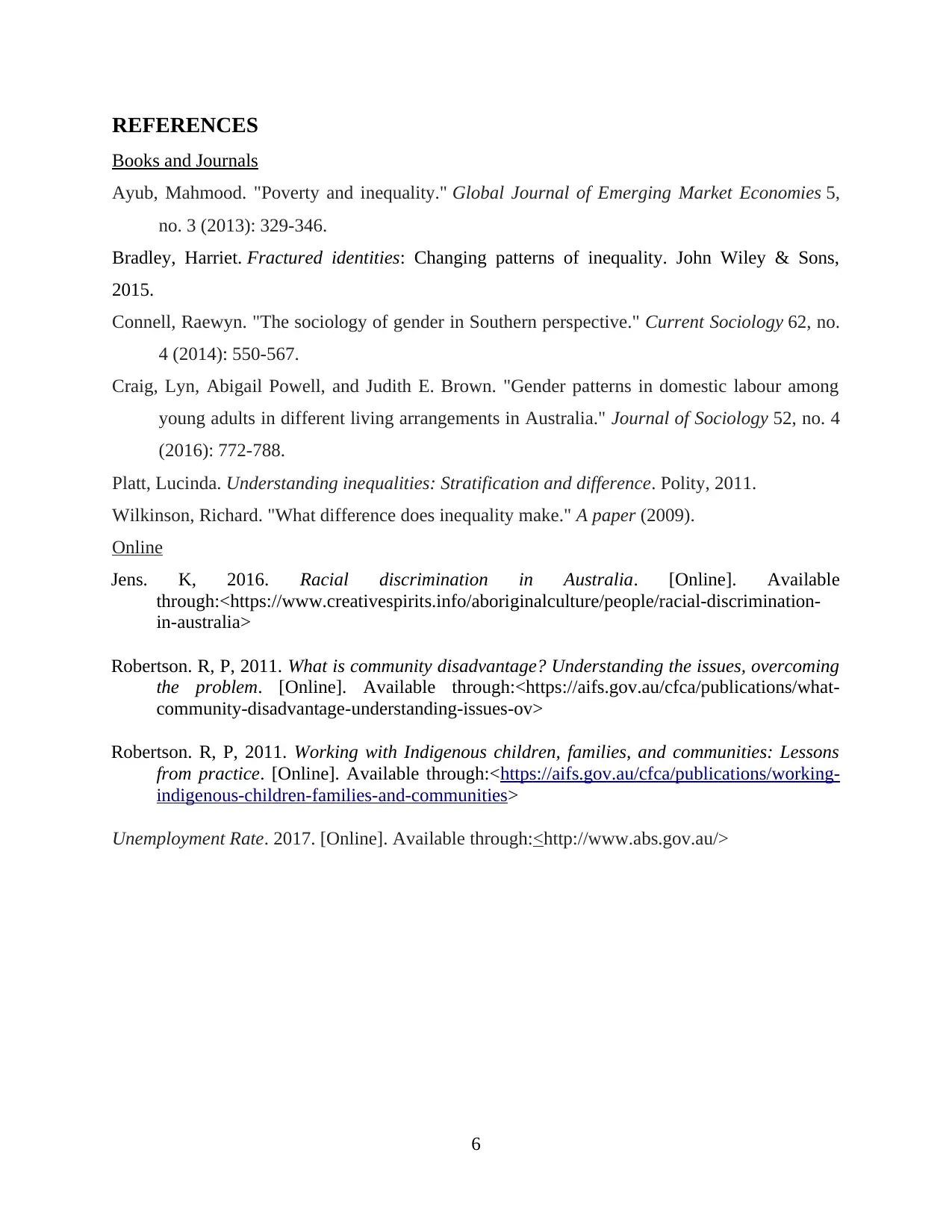
REFERENCES
Books and Journals
Ayub, Mahmood. "Poverty and inequality." Global Journal of Emerging Market Economies 5,
no. 3 (2013): 329-346.
Bradley, Harriet. Fractured identities: Changing patterns of inequality. John Wiley & Sons,
2015.
Connell, Raewyn. "The sociology of gender in Southern perspective." Current Sociology 62, no.
4 (2014): 550-567.
Craig, Lyn, Abigail Powell, and Judith E. Brown. "Gender patterns in domestic labour among
young adults in different living arrangements in Australia." Journal of Sociology 52, no. 4
(2016): 772-788.
Platt, Lucinda. Understanding inequalities: Stratification and difference. Polity, 2011.
Wilkinson, Richard. "What difference does inequality make." A paper (2009).
Online
Jens. K, 2016. Racial discrimination in Australia. [Online]. Available
through:<https://www.creativespirits.info/aboriginalculture/people/racial-discrimination-
in-australia>
Robertson. R, P, 2011. What is community disadvantage? Understanding the issues, overcoming
the problem. [Online]. Available through:<https://aifs.gov.au/cfca/publications/what-
community-disadvantage-understanding-issues-ov>
Robertson. R, P, 2011. Working with Indigenous children, families, and communities: Lessons
from practice. [Online]. Available through:<https://aifs.gov.au/cfca/publications/working-
indigenous-children-families-and-communities>
Unemployment Rate. 2017. [Online]. Available through:<http://www.abs.gov.au/>
6
Books and Journals
Ayub, Mahmood. "Poverty and inequality." Global Journal of Emerging Market Economies 5,
no. 3 (2013): 329-346.
Bradley, Harriet. Fractured identities: Changing patterns of inequality. John Wiley & Sons,
2015.
Connell, Raewyn. "The sociology of gender in Southern perspective." Current Sociology 62, no.
4 (2014): 550-567.
Craig, Lyn, Abigail Powell, and Judith E. Brown. "Gender patterns in domestic labour among
young adults in different living arrangements in Australia." Journal of Sociology 52, no. 4
(2016): 772-788.
Platt, Lucinda. Understanding inequalities: Stratification and difference. Polity, 2011.
Wilkinson, Richard. "What difference does inequality make." A paper (2009).
Online
Jens. K, 2016. Racial discrimination in Australia. [Online]. Available
through:<https://www.creativespirits.info/aboriginalculture/people/racial-discrimination-
in-australia>
Robertson. R, P, 2011. What is community disadvantage? Understanding the issues, overcoming
the problem. [Online]. Available through:<https://aifs.gov.au/cfca/publications/what-
community-disadvantage-understanding-issues-ov>
Robertson. R, P, 2011. Working with Indigenous children, families, and communities: Lessons
from practice. [Online]. Available through:<https://aifs.gov.au/cfca/publications/working-
indigenous-children-families-and-communities>
Unemployment Rate. 2017. [Online]. Available through:<http://www.abs.gov.au/>
6
1 out of 7
Related Documents
Your All-in-One AI-Powered Toolkit for Academic Success.
+13062052269
info@desklib.com
Available 24*7 on WhatsApp / Email
![[object Object]](/_next/static/media/star-bottom.7253800d.svg)
Unlock your academic potential
© 2024 | Zucol Services PVT LTD | All rights reserved.




